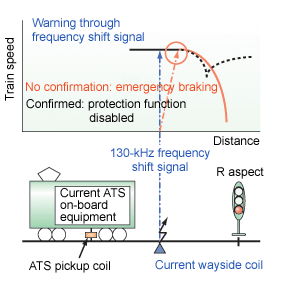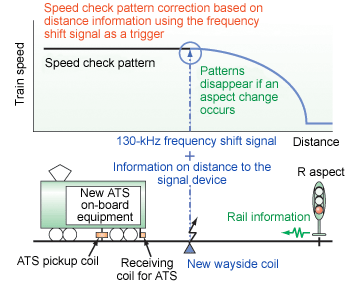| 1. On-Board Speed Check ATS Compatible with the Current ATS | |||||
|
In the current ATS system used on conventional JR line sections, the ATS function is disabled after a driver confirms warnings when approaching a stop signal device. This presents a problem in that no protection can be provided against operational errors that may occur thereafter (Fig.1). A new ATS system was therefore devised to tackle the issue. In the new ATS system, information such as the distance to the stopping signal device is transmitted to the train by a new wayside coil that can transmit digital signals with superimposed circuits, in addition to the same frequency shift signals used by current wayside coils. Speed check patterns are then generated on the train. A system to transmit signal aspects as digital information using the rail has also been added. This enables the swift transmission of signal aspect changes to the train, providing a new system that can be controlled continuously in combination with the new wayside coil (Fig.2). Field tests on digital information transmission through rails and the new wayside coil, which is to be a core technology of the new ATS system, were conducted both in the AC and DC electrification sections. These tests verified problem-free transmission quality for use in the field of engineering. Since existing ATS facilities can be widely utilized when replacing the current facilities with the new ATS system, deployment costs can be reduced. The compatibility of the existing and new systems also enables gradual replacement while the current ATS system is in use. Details of the specifications are now under review in collaboration with seven JR companies for implementation of the new system.
HOME > Major Results of Research and Development in Fiscal 2003 > I Safety/Reliability RTRI HOME Copyright(c) 2004 Railway Technical Research Institute,Tokyo Japan, All rights reserved. |

